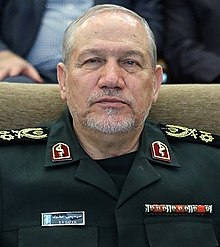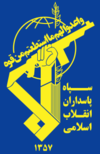| Sardar Yahya Rahim Safavi | |
|---|---|
 | |
| Born | 1952 (age 72–73) Isfahan, Pahlavi Iran |
| Allegiance | Iran |
| Service | Islamic Revolutionary Guard Corps |
| Years of service | 1979–present |
| Rank | Major general |
| Commands | Islamic Revolutionary Guard Corps Ground Forces |
| Battles / wars | |
| Awards | full list |
Yahya "Rahim" Safavi (Persian: یحیی (رحیم) صفوی, born 1952) is an Iranian military commander who served as the chief commander of the Islamic Revolutionary Guard Corps.
Early life
Safavi was born in 1952 in the city of Isfahan, Iran.
Career
Safavi was one of the leaders of the Iran–Iraq War. During the US-led invasion of Afghanistan, he played a key role in the uprising in Herat in November 2001, where American, Iranian and Northern Alliance troops supported a local uprising against the Taliban.
He served as the deputy commander of Islamic Revolutionary Guards Corps until 1997 when he was appointed its commander, replacing Mohsen Rezaee in 1997.
He was replaced as commander of the IRGC by Mohammad Ali Jafari, former director of the Strategic Studies Center of the IRGC on 1 September 2007. Then he was appointed by the Supreme Leader, Ali Khamenei as his special military advisor.
Asset freeze
On 24 December 2006, Rahim Safavi was included on a list of Iranian individuals and organizations sanctioned by the United Nations Security Council Resolution 1737 due to their alleged involvement in the Iranian nuclear and ballistic missile programmes.
Awards and recognition
See also
References
- ^ "Sayyid Yahya Safavi". tasnimnews.com. 30 January 2019.
- ^ "Seyyed Yahya Rahim Safavi". basirat.ir. 30 January 2019.
- Safavi, Karbala 5 Operation iribnews.ir Retrieved 31 January 2019
- Rubin, Michael (Fall 2008). "Iran's Revolutionary Guards – A Rogue Outfit?". Middle East Quarterly. XV (4): 37–48. Retrieved 13 August 2013.
- Sepehri, Vahid (4 September 2007). "Iran: New Commander Takes over Revolutionary Guards". Radio Free Europe. Retrieved 13 August 2013.
- Frederic Wehrey; Jerrold D. Green; Brian Nichiporuk; Alireza Nader; Lydia Hansell; Rasool Nafisi; S. R. Bohandy (2009). "The Rise of the Pasdaran" (PDF). RAND Corporation. Retrieved 20 August 2013.
- "Security Council imposes sanctions on Iran for failure to halt uranium enrichment, unanimously adopting Resolution 1737". United Nations. Archived from the original on 18 May 2012.
| Military offices | ||
|---|---|---|
| New title Military branch created |
Commander of Ground Forces of the IRGC 1985 – 24 September 1989 |
Succeeded byMostafa Izadi |
| Preceded byAli Shamkhani | Second-in-Command of the IRGC 24 September 1989 – 10 September 1997 |
Succeeded byMohammad Bagher Zolghadr |
| Preceded byMohsen Rezaee | Commander-in-chief of the IRGC 10 September 1997 – 1 September 2007 |
Succeeded byMohammad Ali Jafari |
| Commanders of Islamic Revolutionary Guard Corps | ||
|---|---|---|
| Commander-in-Chief |
|  |
| Chief of Joint Staff | ||
| Ground Force | ||
| Aerospace Force | ||
| Navy | ||
| Quds Force | ||
| Mobilization Force | ||
| Intelligence | ||
| Intelligence Protection |
| |
| Supreme Leader Representative | ||
| Ministers |
| |